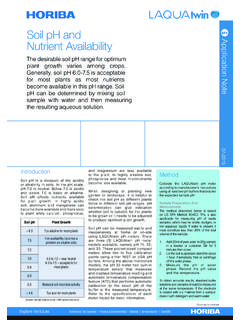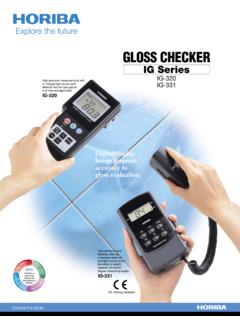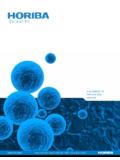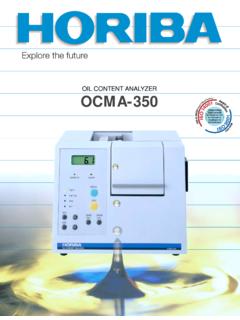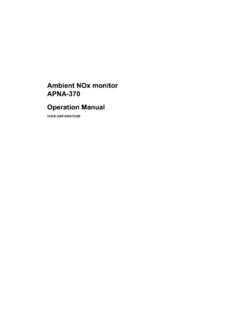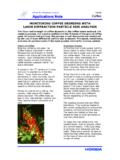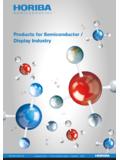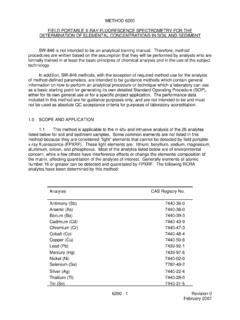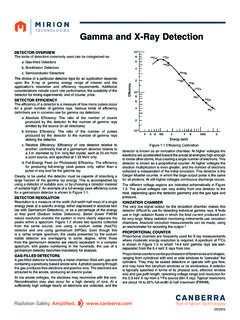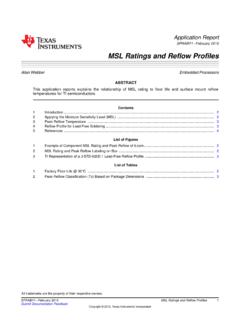Transcription of Tauc-Lorentz Dispersion Formula - HORIBA
1 TN11. Tauc-Lorentz Dispersion Formula Spectroscopic ellipsometry (SE) is a technique based on the measurement of the relative phase change of re- flected and polarized light in order to characterize thin film optical functions and other properties. The meas- ured SE data are used to describe a model where layers refer to given materials. The model uses mathematical relations called Dispersion formulae that help to evaluate the material's optical properties by adjusting specific fit parameters. This technical note deals with Tauc-Lorentz Dispersion Formula . Theoretical model The real part r,TL of the dielectric function is derived from the expression of i using the Kramers-Kronig integration. Jellison and Modine developed this model (1996) using Then, it comes the following expression for i: the Tauc joint density of states and the lorentz oscillator.
2 The complex dielectric function is : ( ).. 2. r (E ) = r ( ) + P 2 i 2 d (5). TL = r, TL + i i, TL = r, TL + i ( i, T i, L ) (1). ~ Eg E. Here the imaginary part i,TL of the dielectric function is where P is the Cauchy principal value containing the resi- given by the product of imaginary part of Tauc's (1966) dues of the integral at poles located on lower half of the dielectric i,T function with lorentz one i,L. In the approx- complex plane and along the real axis. imation of parabolic bands, Tauc's dielectric function de- According to Jellison and Modine (Ref. 1), the derivation scribes inter-band transitions above the band edge as : of the previous integral yields : 2. E Eg . i, T (E > E g ) = AT (2) A C aln E02 + E g2 + E g . E r,TL (E ) = + ln 2 . where : 2 4 E0 E0 + E g E g . 2. - AT is the Tauc coefficient A a 2 Eg +.
3 - E is the photon energy 4a tan arctan + K. - Eg is the optical band gap E0 C . The imaginary part of Tauc's dielectric function gives the 2 Eg . response of the material caused by inter-band mecha- + arctan . nisms only : thus i, T (E Eg) = 0. C . The imaginary part of the Lorentzian oscillator model is given by : +. (. 4 A E0 E g E 2 2 ) K. AL E0 C E 4. i , L (E ) = (3). (E 2. E 0). 2 2. + C2 E2 + 2 Eg 2 Eg . where : arctan + arctan . C C . - AL is the strength of the 2, TL(E) peak - C is the broadening term of the peak - E0 is the peak central energy . (. A E0 C E 2 + E g2 ) ln E E . +K. g By multiplying equation (2) by equation (3), Jellison sets 4 E E + Eg .. up a new expression for i,L(E): 2 A E0 C.. E E g (E + E g ) . 1 A E0 C (E E g ) 2 + E ln (6).. ( ) 2 . g for E > E g 4. 2 2. E0 E g + E g C.
4 2 2. i, TL (E ) = i,L i,T ( 2. ). = E E 2 E02 + C 2 E 2 (4) .. 0 for E E g where A=AT x AL . TN11. where: The parameters of the equations ( 2. g 2. 0 ). aln = E E E + E C E E + 3 E. 2 2. g 2 2. 0 ( 2. 0. 2. g ) The name of the different Tauc-Lorentz formulae present . ( 2 2. )(. aa tan = E E0 E0 + E g + E g C. 2 2 2 2. ) in the DeltaPsi2 software depending on the number of os- cillators are given below. It indicates the number of pa- rameters too. = 4 E0 C. 2 2. (7 ). Number of Number of = E0 C / 2. 2 2. Formula oscillators parameters 4. ( 2. ). = E 2 2 + 2 C 2 / 4 Tauc-Lorentz N=1 5. Extension to multiple oscillators Tauc-Lorentz 2 N=2 8. In the case of multiple oscillators (N>1) the expression of Tauc-Lorentz 3 N=3 11. i contains now a series over all the oscillators. Increasing the number of oscillators leads to a shift of the peaks of absorption toward the ultraviolet region.
5 N 1 Ai Ei Ci (E E g )2. for E > E g 1 parameter is linked to the real part of the dielectric ( 2. i = i =1 E E 2 Ei2 + Ci2 E 2 ) (8) function . 0 for E E g r ( ) = is the high frequency dielectric constant. This is an additional fitting parameter that prevents 1 from and r is re-written as the following sum : converging to zero for energies below the band gap. Generally, >1. N. 2.. ( ). r (E ) = r ( ) + P 2 i 2 d (9) At least 4 parameters describe the imaginary part of the i =1 E. E g dielectric function Deriving this integral yields the analytical expression of Ai (in eV) is related to the strength of the ith absorption the real part of the dielectric function : peak. The subscript i refers to the number (i=1, 2 or 3) of oscillators. As Ai increases, the amplitude of the N . A C a Ei2 + E g2 + E g peak increases and the Full Width At Half Maximum r (E ) = r ( ) + i 4i ln ln 2 (FWHM) of that peak gets slightly larger.
6 Generally, i =1 . 2 Ei . Ei + E g 2. E g 10<Ai<200. Ci (in eV) is the broadening term ; it is a damping coef- Ai aa tan 2 Eg + ficient linked to FWHM of the ith peak of absorption . The arctan + K. 4 Ei Ci higher it is the larger that peak becomes and at the same time the smaller its amplitude is. Generally 2 Eg 0<Ci<10. + arctan . Eg (in eV) is the optical band gap energy. Ci . Ei (in eV) is the energy of maximum transition probability +. (. 4 Ai Ei E g E 2 2 .. ). arctan + 2 Eg .. or the energy position of the peak of absorption . The subscript i refers to the number (i=1, 2 or 3) of oscil- 4 Ci lators. Always, Eg<Ei. 2 Eg . + arctan Limitation of the model Ci . The Tauc-Lorentz model requires i to be zero for energies . (. Ai Ei Ci E 2 + E g2 ) ln E E.. g less than the band gap. Consequently, Tauc-Lorentz mod- E4.
7 E + Eg el does not take into account intra-band absorption : any defect or intra-band absorption increases i below the E E (E + E ) band gap and generates bad fits in that region. +. 2 Ai Ei Ci E g ln . g g (10 ).. ( ). 2 Valid spectral range 4 2. E 2. E 2. + E 2. C . 0 g g i . The Tauc-Lorentz model well describes the behaviour of materials for energies E Ei where Ei is the transition en- ergy of the oscillator of highest order. TN11. Parameter setup Materials Eg ? A E0 C S. R. (eV). The Tauc-Lorentz model works particularly well for amor- a-C - 5. phous materials exhibiting an absorption in the visible AlGaN - and/or FUV range (absorbing dielectrics, semiconduc- As2S3 - tors, polymers). AsSSe - Note that : DLC - 2. - The graph below shows the different contributions (in GaN 1,5 - 3. red dashed lines) to the imaginary part of the Tauc GeSbSe - 3.
8 lorentz dielectric function (in red bold line). InGaN 1,5 - 3. - The sign before a given parameter means that ei- Polymer - 4. ther the amplitude or the broadening of the peak is poly-Si - linked to that parameter. a-Si - Tauc-Lorentz function a-Si:B - a-Si:H - Si xOyNz - Ta-C - 5. ZnS - GeSbTe 0,450 2,024 158,795 1,688 2,397 0,65 - 3. Materials following the Double Tauc-Lorentz model M aterials Eg ? A1 E1. Blue Filte r Ox ide coa ting Polym e r Dielectric function of a-Si represented by a single Tauc-Lorentz SiC * oscillator Ta 2 O 5 Double Tauc-Lorentz function M a t e ria ls C1 A2 E2 C2 S . R . (e V ). B lu e - F i l te r O x id e 4 . 1 4 0 -6 . 2 6 9 * - 5. c o a ti n g P o lym e r - 5. S iC -5 . 1 2 9 * 5 1 . 2 6 4 - T a 2O 5 - This document is not contractually binding under any circumstances - Printed in France - 11/2006.
9 Materials following the Triple Tauc-Lorentz model Materials Eg ? A1 E1 C1 A2. a - Si * HfO 2 Dielectric function of a blue filter represented by a double Tauc- lorentz oscillator Materials E2 C2 A3 E3 C3 S. R. (eV). a - Si - 6. HfO 2. Applications to materials - Materials following the Tauc-Lorentz model References The asterisk * refers to parameters that are negative and 1) Jellison and Modine, Appl. Phys. Lett. 69 (3), 371-374 (1996). thus do not have any physical meaning but represent 2) Erratum, G. E. Jellison & F. A. Modine, Appl. Phys. Lett. 69 (14), 2137 (1996). good starting values to perform the fit on the material. 3) H. Chen, W. Z. Shen, Eur. Phys. J. B. 43, 503-507 (2005).

